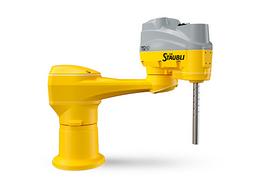
Stäubli launches TS2 robot range
Staubli‘s new TS2 SCARA series, which made its world debut at Automatica, Stäubli is a four-axis machine with JCS drive technology, said to give ultra-short cycle times and it’s ‘hygiene design’ opens up new possibilities for use in sensitive environments.
Stäubli Robotics director Gerald Vogt said: “We have given our SCARAs a complete makeover. They are now modular in design and, for the first time, incorporate our very own JCS drive technology which has been setting new standards in our six-axis machines.
“This technology is the key to the enormous performance gains of the four-axis TS2. Hollow shaft technology has made possible a unique cleanroom design which makes external cabling a thing of the past.”
The differences between the new robots and their predecessors include the design, with internal media and supply lines. There is no external bundling of cables and a sealed housing.
Shortly after the launch of the standard model, versions are to be made available that have been specially modified for pharmaceutical, medical and food applications as well as UL and ESD compliant variants.
“Our new high-speed SCARAs are suitable for all purposes – and much more besides,” Vogt continued. “There are standard robots for all assembly tasks, but these can be upgraded with simple modifications for sensitive production environments, where they open up new application possibilities.
“I am thinking of applications subject to the strictest hygiene or cleanroom requirements, ranging from food and pharmaceuticals to photovoltaics. All TS2 models can be operated with food-grade H1 oil as lubricant without any loss of performance.”
The new robot family consists of four members, the TS2-40, TS2-60, TS2-80 and TS2-100. With the four-axis TS2-100, Stäubli has extended the working radius of the predecessor series (400 to 800 millimetres) to 1,000 millimetres.
Overall, the new SCARAs are more compact than their predecessors and the four-axis machine can be ordered with an optional integrated tool change system, allowing the SCARA’s grippers and tools to automatically replace themselves. Tools or grippers can be changed manually by means of the bayonet locking mechanism. All media and signal connections are automatic.
All machines have the same robot pedestal that the series shares with the six-axis TX2 generation. Also, forearms, axes and drives are identical on certain models. In the case of the forearm, the four models are equipped with one of two different versions, the smaller of which is found on the TS2-40 and TS2-60, the larger on the TS2-80 and the TS2-100.
Vogt adds: “We saw this modular design as a way of significantly reducing delivery times for the new SCARAs. In addition, we save unnecessary costs and rationalise our spare parts provision. We are now using our own JCS drive technology and in any case have a very high level of vertical integration as a matter of policy, which means we are no longer dependent on the reliability of certain component suppliers.”


